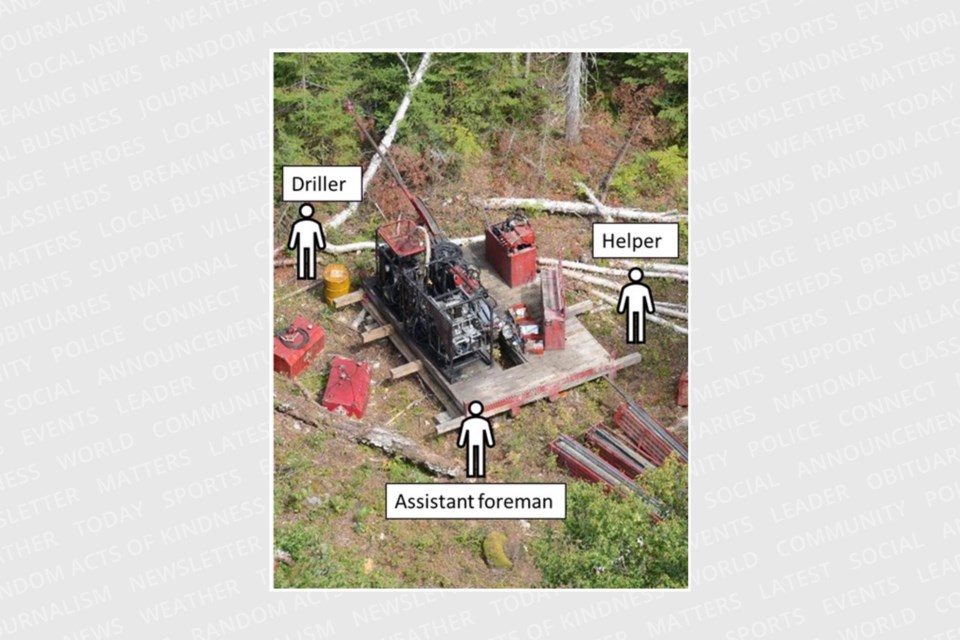The Transportation Safety Board has released its report into an incident last summer near Wawa that resulted in the death of a ground crew member who got tangled in a helicopter tow line. The report shows a similar but non-fatal incident occurred with the same helicopter about a week before the tragedy.
The report by the TSB was released on its website Thursday. The purpose of the report is to advance transportation safety, not to assign blame or liability.
The Airbus AS350 BA helicopter, operated by Cochrane-based Expedition Helicopters Inc., was hired to assist staff of G4 Drilling Canada Ltd. in moving drilling equipment from one site to another just outside of Wawa. At the time, G4 Drilling was operating in support of Angus Gold Inc. mining exploration activities about 46 kilometres west of Wawa.
Two days before the fatal incident on Aug. 20, 2023, the same helicopter and ground crew were conducting a drill move using a cage attached to the craft by lines at a different drill site when a helper was entangled in one of the rigging lines.
"He was lifted approximately 4 feet into the air before the assistant foreman signaled to the pilot to descend," said the report.
The helper was lowered to the ground and was uninjured. The Aug. 18 incident was not reported to any of the companies involved.
On the day of the fatality, the pilot was unsuccessfully attempting to lower the cage starting at about 5 p.m. before telling the ground crew by radio that he needed to refuel. For reasons unknown to investigators, that message was not heard by the ground crew.
In addition to the radio, the crews and pilot were trained to use hand signals to communicate because of the amount of noise typical to the operation of the helicopter.
The pilot could see two of the three ground crew members and did not observe any hand signals that would stop him from ascending. The assistant foreman was not viewable by the pilot because the load was obscuring him.
As the helicopter lifted into the sky, unbeknownst to the pilot, the assistant foreman became entangled in the lines.
"The driller and helper were concentrating on their own tag lines and did not see the assistant foreman become entangled," said the report. "As the helicopter climbed and departed, the assistant foreman was carried aloft."
When the two members of the ground crew still on the ground realized the assistant foreman was tangled and being carried upward, the pilot was called over the radio.
"However, the radio call was made in French, and given that the pilot did not understand French, he could not understand what was being said," said the report. "The pilot departed the area and climbed to approximately 200 to 300 feet above ground level over the nearby lake."
Moments later, the remaining ground crew watched helplessly as the assistant foreman fell from the helicopter. At 5:22 p.m., the remaining ground crew radioed the base camp to report the incident.
The pilot felt something had gone wrong by the tone of the voice over the radio, landed at another site and picked up the foreman. They returned to the site of the incident and became aware of what happened.
A search found the assistant foreman on land in a forested area across the lake from the site. He had been fatally injured.
As a result of the fatality, Angus Gold has implemented an indoctrination session, which includes information on helicopter safety for persons, including contractors, accessing drill sites and working near or with helicopters. The company has also purchased noise-cancelling helmets that can be connected to the radios, and has implemented procedures for using these helmets when conducting longline operations.
Additionally, G4 has changed the kind of tag lines it uses to a kind less likely to coil upon itself, making it less likely someone could become entangled.
The TSB reminds pilots they should be able to see that all ground crew members are clear of the loads before lifting them off the ground and ground crew members must exercise caution and vigilance when working with external loads to avoid situations that could lead to entanglement.
"Personnel who operate radios are reminded that communications need to be made clear by using language and terminology that can be understood by all parties involved, and these transmissions should be acknowledged to ensure that the message is understood," said the report. "In addition, the communications equipment needs be suitable for the task and take into consideration the environment in which the communications are being made."
